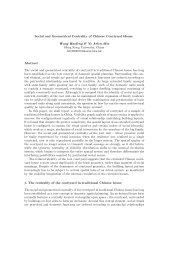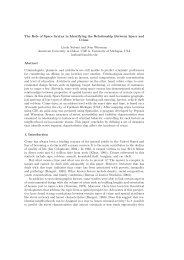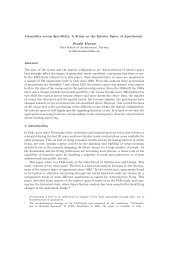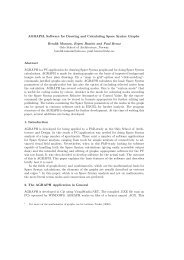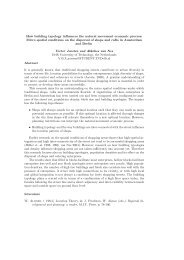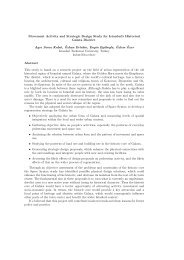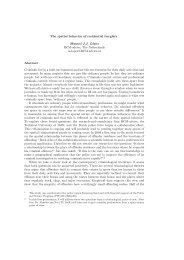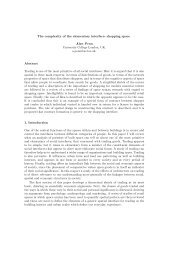High Resolution Analysis of Crime Patterns in Urban Street Networks
High Resolution Analysis of Crime Patterns in Urban Street Networks
High Resolution Analysis of Crime Patterns in Urban Street Networks
Create successful ePaper yourself
Turn your PDF publications into a flip-book with our unique Google optimized e-Paper software.
474 B. Hillier and O. SahbazFigure 238:Figure 239:11. DiscussionThe aim <strong>of</strong> this prelim<strong>in</strong>ary statistical analysis has been to l<strong>in</strong>k the spatial and temporalpattern<strong>in</strong>g <strong>of</strong> crime with the spatial and temporal dynamics <strong>of</strong> the city and how it works.Although this is only the first stage <strong>of</strong> the research, we see that the <strong>in</strong>ter-dependence <strong>of</strong>crime and space is much more complex and variable than is <strong>of</strong>ten believed. The results<strong>of</strong>fer hope that with a more precise understand<strong>in</strong>g <strong>of</strong> the relation between urban spatialdynamics and different k<strong>in</strong>ds <strong>of</strong> crime, it will be possible to develop a more sophisticatedapproach to how to design city areas for urban levels <strong>of</strong> use without <strong>in</strong>curr<strong>in</strong>g penalties<strong>in</strong> terms <strong>of</strong> <strong>in</strong>creased crime.The most critical f<strong>in</strong>d<strong>in</strong>g that has come to light <strong>in</strong> this study is the relation betweenspatial scale and the choice between grid like or tree layouts. In residential areas, the moredwell<strong>in</strong>gs that lie on street segment between junctions then, other th<strong>in</strong>gs be<strong>in</strong>g equal, thesafer you are from both burglary and robbery. This applies both to through streets and culde-sacs.For example, although the mean rate <strong>of</strong> burglary for 1 and 2 connected segments(which for the most part will be cul-de-sacs or cul-de-sacs) <strong>in</strong> the data is .105, aga<strong>in</strong>st anoverall average <strong>of</strong> .168 for all segments, cul-de-sacs with no more than 10 dwell<strong>in</strong>gs havea rate <strong>of</strong> .209 (calculated aga<strong>in</strong> as the total number <strong>of</strong> burglaries over the total number<strong>of</strong> dwell<strong>in</strong>gs <strong>in</strong> such segments, so the rate is a true one), while 6 connected (grid like)segments with more than 100 dwell<strong>in</strong>gs have a rate <strong>of</strong> .086, and the much larger numberwith 50+ have a rate <strong>of</strong> .142.Social factors also play a role. By divid<strong>in</strong>g the data <strong>in</strong>to those with above averagecouncil tax bands (and so more valuable property), 6-connected segments with more than50 dwell<strong>in</strong>gs per segment and higher tax band and no nonresidential, the burglary rate



